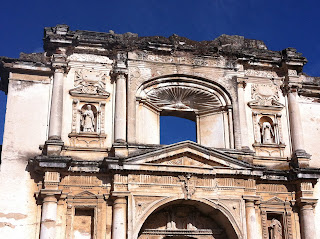57 hours. That's how long it took me to reach my final destination. What I
thought would be a straightforward trip added up to an adventurous 57 hours.
For most students, getting a
much-needed break at home is the light at the end of the dark tunnel following
finals week. However, this semester the light at the end of my tunnel didn’t
shine from home, but from an entirely different hemisphere.
Traveling itself isn’t as foreign to
me as it once was. In the past two years I have had the opportunity to travel
to 10 different countries around the world. However most of those trips I’d
been in the company of friends and classmates. What made my trip to the
Galapagos different was that this time, I’d be completely on my own, at least
for a while.
 |
| Tools of Backpack Journalism |
So, on the Friday night in which
final exams were complete, I got in my car at 10:00pm and drove overnight to
Seattle to catch the first leg of my journey. The flights themselves
were pretty uneventful. Besides the fact all of them were delayed for one
reason or another, things were going pretty smoothly. Sure, I was
tired, but traveling takes it out of everyone. By the time I reached the
Guayaquil airport in Ecuador my tiredness was being replaced by a growing
feeling of excitement.
"Just one short flight, and I
will arrive at my destination," I excitedly thought to myself as I cleared
customs, and headed to check in with the airline worker at the counter.
As I began to check in, the woman began explaining where I needed to go. Half way through she paused as she glanced down at my boarding pass.
 |
| It's gonna be a long day |
She then proceeded to tell me slightly different instructions, and as she did, I became confused.
"I am going to San Cristobal," I said, cutting her off mid-sentence.
"This flight is to Baltra," she explained.
Slowly, I felt my previous rush of excitement being replaced by a growing sense of dread. Surely there must have been some kind of mistake, I dug through my papers realizing that all my itineraries confirmed what they were telling me. The Seymour airport wasn't in San Cristobal as I had previously thought, but Baltra, an island that felt like it may as well be a world away.
Panicking as I entered the terminal, I took out my laptop and began emailing my professors and trip
 |
| Layover Survival Kit! |
Directly off the plane I went to collect my luggage, only to find it had not arrived. Now not only was I on the wrong island, I was on the wrong island in the same clothes I'd been wearing now for two days. Just my luck.
The ticket counter where I was supposed to buy my bus ticket was also closed, so I got on the airport bus hoping that if and when I crossed the ferry, there would be a way to buy a ticket once I got there. The bus from the airport did drop me off at a ferry, which so far was the first good sign I received in a while. As soon as my feet touched land off the ferry, I rushed to the bus with the company letters I was told to get on.
 |
| Headed to the wrong island, but the view from the plane is cool |
"I don't know, I don't I'm not the driver, I just look like I am," he cheerfully said in a thick Australian accent.
The man, who I later found out was named Doug, helped me onto the bus, and as we stepped on, it immediately began its departure.
"I'm headed to Puerto Ayora, and everyone else seems to be as well, so let's hope that's where its going," Doug told me, seemingly without a worry in the world.
The bus was hot, and filled to what was definitely way over its maximum capacity. All the seats were filled, and so was the aisle. Doug, the last one on the bus was squeezed against the door, and I stood on one of the steps.
 |
| The crowded bus ride across Santa Cruz |
"Oh no, you just missed it," explained the workers in the information booth.
 |
| Lost my luggage - just my luck. |
They told me the next one wasn't until the next morning at 7:00. Wrong island, no luggage, missed boat. It seemed like my losses were really out-numbering my wins at this point. I left the pier and crossed the street where I saw a shop advertising boats to San Cristobal. Their price was $30, which was what the information I was given said it would be. I went inside and bought my ticket. The lady told me the boat would leave at 7:00 am sharp, so I should be sure to get there by 6:30 am.
I found a hotel with Internet for the night, sent emails to my parents, professor, and coordinator, assuring them that I was still alive and safe. After exploring Puerto Ayora a bit, I went back to my room and got what I felt to be some well deserved sleep.
---
 |
| Enjoying the Beautiful island of Santa Cruz While I can |
 |
| Santa Cruz wildlife |
After what felt like the longest voyage to the islands since Charles Darwin's in 1831, I have finally arrived.
 |
| Finally in San Cristobal! Giving in for the day and becoming one... |





















